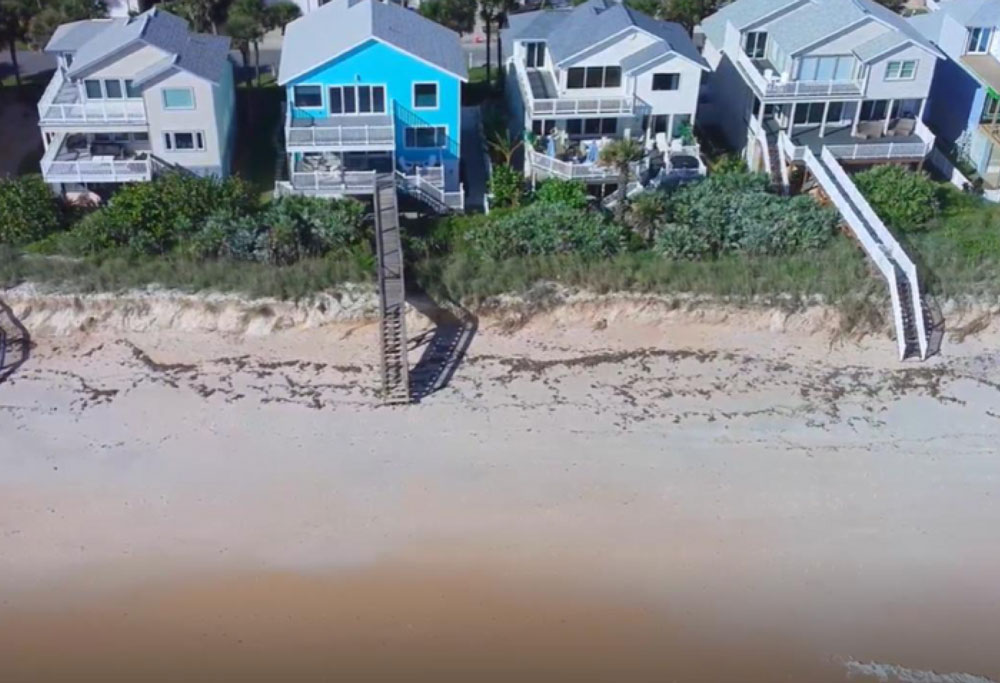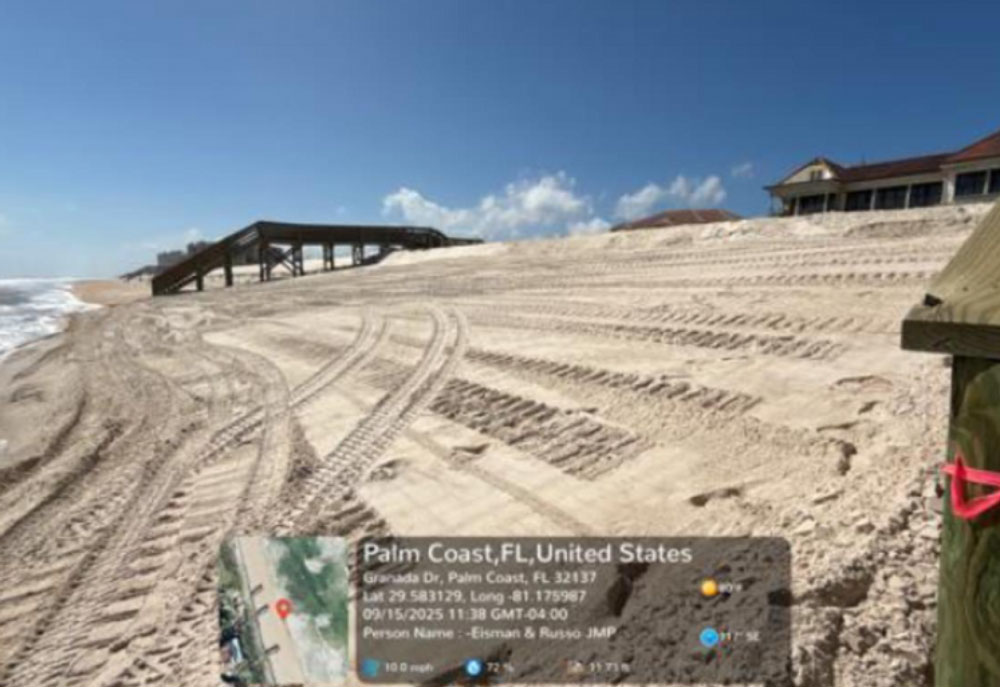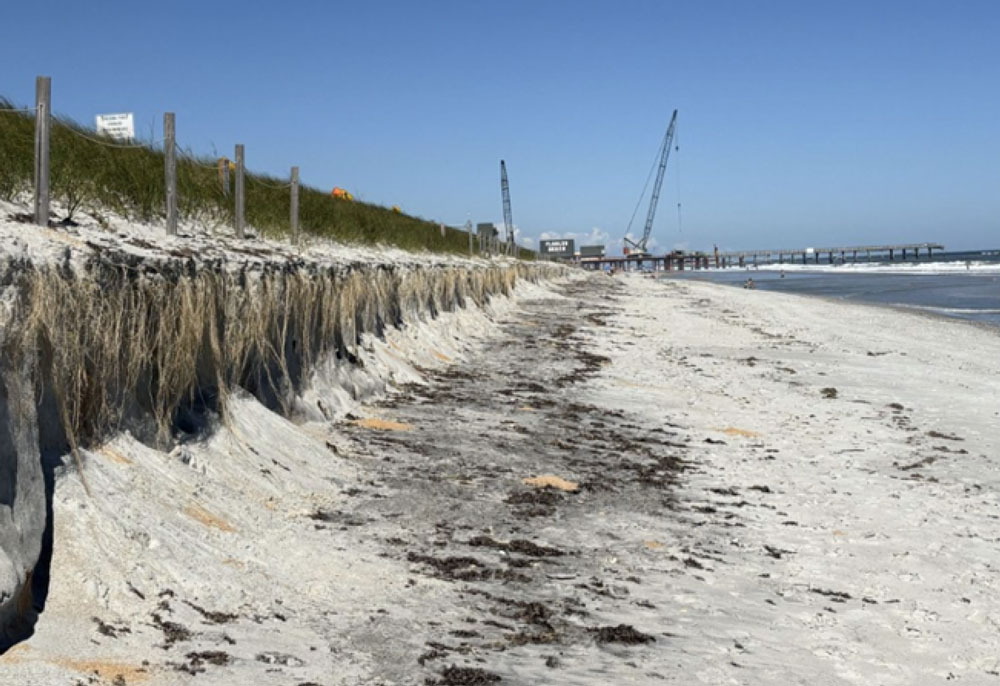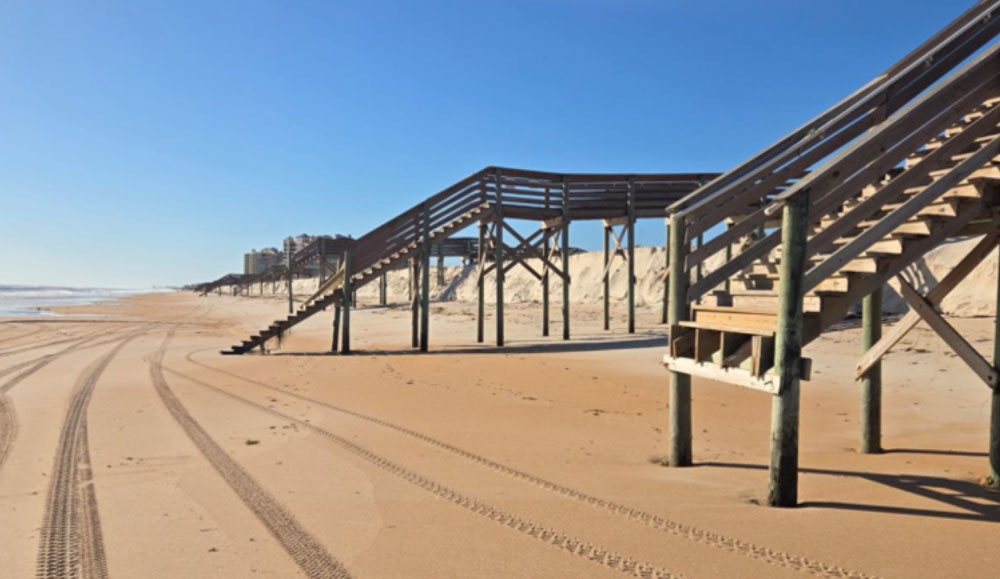
The nor’easter that barreled through the region between October 10 and October 14 caused uneven but significant and in some places severe damage to Flagler County’s 18 miles of shoreline, with beaches toward the north holding up better than beaches further south.
A thorough analysis based on on-the-ground observations and drone footage reveals that no stretch of beach was spared erosion. In one stretch near Hammock Dunes, half the sand just dropped to rebuild 1.1-miles of beach in a $10 million project was lost. (The loss affected the 30 percent stretch of the project that had been completed before the storm. The project is ongoing.) In most places where the county had rebuilt dunes in 2023, the sand has been severely eroded.
The analysis underscores an expensive reality: it is not enough to keep building sacrificial dunes. The beaches in front of the dunes must be rebuilt, too. The county has a plan to do both, but not much funding left to build dunes and no funding to rebuild beaches, beyond one 2026 project, as political squables continue to paralyze the County Commission on that score.
“When I first came to Flagler County, everyone was about restoring the dunes,” says Ansley Wren-Key, Flagler County’s coastal engineering administrator. “And I was like, why are they just focused on dunes? We have to build beaches to protect the dunes.”
With a doctorate in the science and years of experience, Wren-Key is the county’s leading expert in the field. She frequently attempts to explain the difference between building dunes and beach renourishment. The two are not the same. Beach renourishment is exactly what it says: it replenishes the sand on the beach itself. It rebuilds the beach, restoring the area where beachgoers spend their time, stretching it back toward the sea.
That’s what the U.S. Army Corps of Engineers project did in Flagler Beach. Beaches that had eroded down to nonexistence at high tide were back to 60, 70, 80-yard wide beaches even at high tide.
Renourishment includes dune-building. But dune-building alone does not include beach renourishment.
Marineland and Northern Flagler County: Drone Footage
With one exception, every one of the rebuilding projects Flagler County has conducted along its 18 miles of shoreline since Hurricane Matthew in 2016, and there have been many (costing well over $100 million) have been dune-rebuilding projects. Sacrificial dunes, at that: without renourished beaches in front of them, the dunes are bound to erode fast, as they have. The one exception has been the additional stretch of renourishment the county paid for, with state grants, on the north and south sides of the Army Corps project. The county in 2026 will be renourishing an additional 5.5 mile stretch north of that project line, in Flagler Beach. (See: “Flagler County Prepares to Rebuild 5.5 Miles of Beach for $36 Million North of Pier Even as Long-Term Plan Is In Doubt.”)
So for beaches to be restored and to be resilient in the face of future storms, Wren-Key says, renourishment—not just dune-building—is key.
“It had been pretty stable here until Matthew hit,” Wren-Key said, “and then there was that series of Irma, Dorian, Nicole, Ian, and it’s so sediment-starved. It’s just so eroded. The only solution is to come back in, build a big dune and then a beach in front of the dune to protect the dune itself.”
Wren-Key, County Administrator Heidi Petito and Deputy County Administrator Percy Sayles took part in an hour-long interview this week to explain the county’s beach analysis after the nor’easter, and to place the beach’s needs in perspective. The county also produced a document illustrated with images and videos of the entire shoreline, from which the illustrations and videos in this article have been pulled.
The following is a neighborhood-by-neighborhood summary of the beach analysis, starting from the north end of the county.
Parts of Marineland by the River to Sea Preserve, Marineland Acres, MalaCompra Park, Painters Hill did relatively well. “There was some erosion, but nothing that would be alarming,” Wren-Key said. “It was just your typical nor’easter, small scarps, the sand most likely will come back when we have some fair weather.”
Bay Drive Park and Ocean Hammock Dunes did not fare as well. That’s where half the sand recently dropped in the ongoing dune-rebuilding project was lost, leaving 6 to 8-foot “scarps,” those cliff-like walls of sand in place of what used to be sloping dunes, which signal serious erosion from wave action.
Hammock Dunes south of Jungle Hut Road was also severely eroded. Where ample dunes had sloped down to the high-tide sea, covering half the walkovers’ foundations, little is left. The walkovers stand as naked as skeletons again, the new sand gone, with 6-to 12-foot scarps, or cliffs, marking a duneline that has receded back to near houses. Naked walkovers’ pilings mean that the structures are more vulnerable to damage in the next storm. It doesn’t have to be a severe one.

Same story at the Hammock Dunes condominiums, where dunes as wide as 20 feet before the storm were cut in half.
At Sea Colony, just 10 to 20 percent of the sand that rebuilt dunes in 2023 remains, with the buffer between houses and the cliff-like dunes down to a dozen yards.
At Varn Park, the scarps are not as high, but there is no high-tide beach to speak of, and little beach at mid-tide. The beach itself has been “deflated,” meaning that its pack of sand has thinned so much that it provides no resistance to the sea, making further erosion on what’s left of the duneline easier.
Erosion is severe around Beverly Beach, where an RV campground’s seawall collapsed and the duneline receded considerably, leaving 8 to 10-foot scarps and—what had not been the case in the 2021 nor’easter or previous tropical storms—the exposure of coquina rock in many places, signaling the serious thinning of the beach surface.
This is what Wren-Key refers to as a “sediment-starved” beach.
In Beverly Beach and north Flagler Beach: Drone footage
Erosion and scarps diminish somewhat at the south end of Beverly Beach and as you move into Flagler Beach, though it becomes a half-full, half-empty judgment at that point: that’s the location of the Department of Transportation’s buried secant seawall, which became entirely exposed in the 2021 storm.
In this case, some of the fresher sand remains, but not enough to keep underlying boulders from being exposed, with cliff-like scarps above them and weakened walkovers around them. On the other hand, the wall itself continues to protect State Road A1A. Its performance through the 2021 storm spurred the building of another, longer pair of secant walls at the south end of Flagler County (completed just in time for this storm) and in Volusia County. The erosion in that area near the Flagler-Volusia County line is significant for the beach, and it has created high scarping, but the wall remains buried.
Further south, around North 14th Street, the shape of the beach has again served it well, with aging but resilient and still-vegetated dunes’ slopes surviving, and indicating that they once again managed to absorb the harsher effects of the waves. That’s the case as you move south toward the Flagler Beach boardwalk and toward the pier, where construction of the new pier has created an artificial environment that for now prevents the usual assessment of beach damage. A simple wooden fence at the bottom of the duneline appears to have helped limit erosion.
The U.S. Army Corps Project: Drone footage of the 2.6 miles:
Scarps reappear south of the pier. That’s the area of the U.S. Army Corps of Engineers’ renourishment project, completed only in August 2024. The project has experienced a significant loss of sand and scarps now show up somewhat high on the duneline, near the vegetation. The renourishment was intended to last 11 years before another one would be necessary. That 11-year stretch is now “outdated,” as Wren-Key says. Six years is more likely, if not sooner. But Flagler Beach and Flagler County have no money to put toward it. (Flagler Beach just pledged to generate about $750,000 a year for the purpose, but that’s a fraction of the cost ahead.)
“When the Corps had originally brought it forward, they were anticipating it to be 11” years, Petito, the county administrator, said. “It’s a ballpark. When they were looking at it, they didn’t know what would happen to the coastline, how fast would it erode. The conditions change all the time.” The county’s consultant a few years ago concluded that six years was more realistic.
Wren-Key cautions that while sand has washed out to sea in the Army Corps zone, the loss is different than north or south of it, because lost sand in the Army Corps zone is still in the “nearshore,” and should be understood more as seasonal, migrating sand: it comes back. After Hurricane Milton, the Corps’s analysis showed the beach had gained sand, if the sand offshore was included.
That’s the sign of a healthier beach, where the beach surface itself has been built up and seasonal loss or loss due to storms ends up being less consequential than it is where the beach is sand-starved.

That’s what underscores the importance of not only rebuilding dunes, but of renourishing beaches, Wren-Key says. One without the other is not an effective way to preserve the beaches.
“When you build a beach in front of the dune, the dune should not be impacted regularly, unless you get a hurricane. That’s the last buffer between the ocean and the infrastructure. So typical nor’easters and even small hurricanes should be impacting the beach.”
At the moment, Flagler County has no beach-protection program in place. The beach-renourishment project it will carry out on 5.5 miles of beach north of the pier will be its last funded project of that size, and its only beach-renourishment project. Additional projects are to rebuild sacrificial dunes, in back of emaciated beaches. The dunes will not last. The County Commission was close to adopting a comprehensive, funded beach-management plan, but three county commissioners eventually opposed it, because it relied on a sales tax increase.
For now, the county has a beach management plan, but no money to enact it, and only one certainty ahead: more storms.
“If we maintain our beach nourishment program, like Jacksonville Beach has done, we can build back all of the healthy dunes and a big, wide beach,” Wren-Key said. “But we have to renourish it on the regular interval that it needs. And after a while, you won’t have to renourish it as much, like Jacksonville’s beach, and it’ll become a stable environment.”
![]()
Bay Drive Park: Drone Footage






























Mark says
It would seem prudent to me that in the near future before they dump one bucket of sand someone look at a calendar for the worst months of storms, then start their projects accordingly. Why dump sand in August just to watch it disappear a month or two later. Rebuild in January and plant as much as you can to hold that dune together, those plants can stretch their legs and get a good footing before hurricane season. I’m all for having a half penny tax only if they are going to rebuild smartly and not watch all that money go to sea.
D. says
Exactly, They always start these projects right be before or during hurricane season. They might as well throw the.moneynin the ocean.
Laurel says
Pinellas County was able to do this without putting a lopsided burden on residents:
https://www.humistonandmoore.com/about1-c21rk
Pogo says
@Laurel
Update:
https://www.google.com/search?q=current+condition+status+honeymoon+beach+fl+2025
And don’t forget
https://www.google.com/search?q=honeymoon+beach+fl+red+tide
And
https://www.google.com/search?q=sea+level+fl+2040
And finally
https://www.google.com/search?q=the+water+will+come
And we will go — where?
Laurel says
Our lives, and tax assessments, are dictated by the few who financially benefit from tourism, and by those who poorly planned homes, golf courses and club houses.
If the county is going to preserve the beaches for a period of time, they need barriers.
South Florida has two things this area does not. One is deep water. The other is barriers. This area has rip current warnings nearly every day of the year. You can see the scalloped sand from the road, and you can feel a sudden drop when walking in the water. On south Flagler Beach, you can see orange bubbles as the newer orange dirt is pulled up from the bottom.
However, there is a natural sand bar, and maybe that should interest some people.
If the people want to protect their homes, golf courses and club houses, they should do so themselves. Because many came here in just the last 15-20 years, they want us all to fix it. At this late in time, it is way too expensive to do that, and they are dragging us all into it, claiming it benefits all of us, so we’re supposed to suck it up. Especially those of us simply on the east side of the river.
JimboXYZ says
The futility of this astonishes me, that anyone in Government revisits what the rest of the community needs to pay additionally so that every year the reassessment needs to be done again. The last effort to rebuild the beaches lasted maybe a year ? And this year the hurricanes & tropical storms haven’t affected Flagler County to the extent of the most recent 3 years. 1/2 of the dune rebuilds are gone in less than 1 year ?
There’s a fellow on Facebook that is the “guru” of Matanzas Inlet. The beach rebuild & there’s an inlet that existed long before the existing optics of the current Matanzas Inlet layout as we’ve all known it ever since Marineland & Palm Coast have ever existed, perhaps even Bunnell or Flagler Beach too. Penon Inlet is re-establishing itself. The worst part of it, they’ve known this and still come back for taxes & any other way to extort a payment from anyone. Planet Earth will evolve, the county coastline was nice while it lasted, throwing money into the Atlantic Ocean has ceased to be a noble cause, it’s a fool’s errand. And our politician’s are fools of the highest order. In denial that planet Earth is bigger than their egos. That must be humbling the narcissists of leadership trying to rally taxpayers to accept millions of contributions to save a coastline that is the equivalent of modern medicine trying to cure death with higher insurance premiums. We did it their way for the last 4 years. We fought that, they still did it, & this
is where we are. Penon Inlet was filled in on favor of Matanzas Inlet as a single inlet & bridge. It’s reforming to the way planet Earth designed it before the US Army Corps of Engineers thought they knew better than the almighty himself when Planet Earth was created. The one’s that are higher educated, we emplore you, prove to the rest of us stupid dolts that the education from that Ivy League University is worth more than the paper it’s printed on. That the education system hasn’t failed leadership ? That the admission requirements are something more than fabricated K-12 for picking winners & losers. That out governments aren’t full of con artists.
https://www.youtube.com/watch?v=5uj5p0t9Bmg
“https://www.facebook.com/watch/?v=434828071494645”
Deborah Coffey says
Jimbo, it always makes me smile when I totally agree with you, which is almost never. Good comment!
Mothersworry says
The only way imho to slow the destruction of the beach and dunes is to do what works in the Northeast. Sea walls and breakwaters. Not this short thing that was just built south of the water tower that at the current rate of erosion will be washed over next year. A breakwater slows the speed and lessens the destructive force of a wave. A taller wall keeps the ocean down. They have worked for years in New England and continue to do so. I get that the ocean takes sand away and actually puts some back. But what has been taken this time in a massive amount.
Maybe if the Feds stopped spending money on BS stuff like a ballroom, patios, and marble bathrooms they could help to save the coastline. Silly me, what the hell was I thinking!
Ed P says
Sea turtle nesting….3 words
Laurel says
Interestingly enough, the ocean tends to place the sand back in the inlets!
Food for thought.
Brian Riehle says
As I posted here last month, after living in Flagler County for 25 years the score is still
Mother Nature – 25 and Beach Renourishment -0.
Diane J. Cline says
We need to stop dumping sand that only lasts until the next storm. Call it whatever you want, dune building or beach building, the sand can’t stand up to the strong currents. Yes, the correct plants on the dune help, especially the ones that impede the sand from blowing such as the much maligned saw palmetto, however to correctly address the problem is to slow down our currents. Head on would require a wall out in the water which is of course ridiculous however that’s why groins are built. Groins impede the flow north to south and vice versa. If you are not familiar with them there are a few on the beach in Marineland. I was told by an official (don’t know if they were State or Fed) that groins are no longer in favor but I think that train of thought needs to be reversed and we need to be adamanet in demanding them. I’m tired of seeing my hard earned tax dollars wash out to sea!
Dean Gallberry III says
Note to editor: I believe the word “scarp” (and “scarps”) was intended throughout, where “scrap” was used.